Microstructural Properties and Wear Resistance of Fe-Cr-Co-Ni-Mo-Based High Entropy Alloy Coatings Deposited with Different Coating Techniques
Abstract
:1. Introduction
2. Materials and Methods
2.1. Materials and Coating Processes
2.2. Surface Morphology and Microstructural Analysis
2.3. Hardness Test
2.4. Tribological: Friction and Wear Testing
3. Results and Discussion
3.1. Surface Morphology, Microstructure and Chemical Composition
3.1.1. Morphological and Microstructural Characterization of HVOF HEACs
3.1.2. Morphological and Microstructural Characterization of ESD HEACs
3.1.3. Morphological and Microstructural Characterization of the LC HEACs
3.2. X-ray Diffraction (XRD) Analysis
3.3. Micro-Hardness of the HEACs
3.4. Surface Roughness of the HEA Coatings (HEACs)
3.5. Sliding Friction Coefficient and Wear Behavior
3.6. Worn Scar Morphology and Wear Mechanism
4. Conclusions
- The results indicate that the HVOF and LC were more efficient deposition techniques than ESD in the powder melting of all elements, producing a relatively even surface and cross-section microstructure for both HEA compositions (Co19Cr17Fe19Ni18Mo27 and Co20Cr20Fe20Ni20Mo20). The surface morphology correlated with the topographic features. Accordingly, the surface roughness was very large in all cases, representing a potential concern during running-in for practical applications.
- The results showed that Co19Cr17Fe19Ni18Mo27 had better mechanical and tribological performance than Co20Cr20Fe20Ni20Mo20. The Co19Cr17Fe19Ni18Mo27 had lower roughness, coefficient of friction and wear rates compared to the equiatomic Co20Cr20Fe20Ni20Mo20 HEA coating.
- Three major phases: A mixture of FCC and BCC and a residual BCC phase linked to the Mo element were detected in both HEAC compositions, and additionally two intermetallics (σ phase and Mo-rich phase concluded as µ phase). In Co19Cr17Fe19Ni18Mo27, a mixture of σ and µ phase precipitation occurred, while the µ phase was only observed in Co20Cr20Fe20Ni20Mo20.
- The variation in microstructure and hardness of each coating was explained by the difference in Mo content in the coatings, which contributed to improved resistance to deformation through the formation of BCC, σ and presumably the µ phases.
- The coatings wore out by a mixed-abrasive and oxidative wear mechanism for the HVOF HEACs. For ESD HEACs and LC HEACs, delamination occurred in areas where abrasive wear was severe and transitioned into adhesive wear, but the adhesive oxidative layers compromised excessive surface damage.
- Despite Co19Cr17Fe19Ni18Mo27 coating producing better results than Co20Cr20Fe20Ni20Mo20 from this study, more research on the coating properties would be beneficial before usage in a geothermal environment, such as corrosion resistance, due to the complex microstructure produced from mechanical alloying and the powder deposition, which plays a crucial role in the performance of the alloys.
Author Contributions
Funding
Institutional Review Board Statement
Informed Consent Statement
Data Availability Statement
Acknowledgments
Conflicts of Interest
References
- Hoornaert, T.; Hua, Z.K.; Zhang, J.H. Hard Wear-Resistant Coatings: A Review. In Advanced Tribology; Springer: Berlin/Heidelberg, Germany, 2009; pp. 774–779. [Google Scholar] [CrossRef]
- Yeh, J.-W.; Chen, S.K.; Lin, S.-J.; Gan, J.-Y.; Chin, T.-S.; Shun, T.-T.; Tsau, C.-H.; Chang, S.-Y. Nanostructured High-Entropy Alloys with Multiple Principal Elements: Novel Alloy Design Concepts and Outcomes. Adv. Eng. Mater. 2004, 6, 299–303. [Google Scholar] [CrossRef]
- Ye, Y.; Wang, Q.; Lu, J.; Liu, C.; Yang, Y. High-entropy alloy: Challenges and prospects. Mater. Today 2016, 19, 349–362. [Google Scholar] [CrossRef]
- Miracle, D.B.; Miller, J.D.; Senkov, O.N.; Woodward, C.; Uchic, M.D.; Tiley, J. Exploration and Development of High Entropy Alloys for Structural Applications. Entropy 2014, 16, 494–525. [Google Scholar] [CrossRef]
- Senkov, O.N.; Miracle, D.B.; Chaput, K.J.; Couzinie, J.-P. Development and exploration of refractory high entropy alloys—A review. J. Mater. Res. 2018, 33, 3092–3128. [Google Scholar] [CrossRef] [Green Version]
- Liu, W.; Lu, Z.; He, J.; Luan, J.; Wang, Z.; Liu, B.; Liu, Y.; Chen, M.; Liu, C. Ductile CoCrFeNiMox high entropy alloys strengthened by hard intermetallic phases. Acta Mater. 2016, 116, 332–342. [Google Scholar] [CrossRef]
- Senkov, O.; Senkova, S.; Woodward, C.; Miracle, D. Low-density, refractory multi-principal element alloys of the Cr–Nb–Ti–V–Zr system: Microstructure and phase analysis. Acta Mater. 2013, 61, 1545–1557. [Google Scholar] [CrossRef]
- Shu, F.; Yang, B.; Dong, S.; Zhao, H.; Xu, B.; Xu, F.; Liu, B.; He, P.; Feng, J. Effects of Fe-to-Co ratio on microstructure and mechanical properties of laser cladded FeCoCrBNiSi high-entropy alloy coatings. Appl. Surf. Sci. 2018, 450, 538–544. [Google Scholar] [CrossRef]
- Niu, Z.; Wang, Y.; Geng, C.; Xu, J.; Wang, Y. Microstructural evolution, mechanical and corrosion behaviors of as-annealed CoCrFeNiMox (x = 0, 0.2, 0.5, 0.8, 1) high entropy alloys. J. Alloys Compd. 2020, 820, 153273. [Google Scholar] [CrossRef]
- Lehtonen, J.; Koivuluoto, H.; Ge, Y.; Juselius, A.; Hannula, S.-P. Cold Gas Spraying of a High-Entropy CrFeNiMn Equiatomic Alloy. Coatings 2020, 10, 53. [Google Scholar] [CrossRef] [Green Version]
- Cantor, B.; Chang, I.T.H.; Knight, P.; Vincent, A.J.B. Microstructural development in equiatomic multicomponent alloys. Mater. Sci. Eng. A 2004, 375–377, 213–218. [Google Scholar] [CrossRef]
- Miao, J.; Guo, T.; Ren, J.; Zhang, A.; Su, B.; Meng, J. Optimization of mechanical and tribological properties of FCC CrCoNi multi-principal element alloy with Mo addition. Vacuum 2018, 149, 324–330. [Google Scholar] [CrossRef]
- Tsai, M.-H.; Tsai, R.-C.; Chang, T.; Huang, W.-F. Intermetallic Phases in High-Entropy Alloys: Statistical Analysis of their Prevalence and Structural Inheritance. Metals 2019, 9, 247. [Google Scholar] [CrossRef] [Green Version]
- Shun, T.-T.; Chang, L.-Y.; Shiu, M.-H. Microstructure and mechanical properties of multiprincipal component CoCrFeNiMox alloys. Mater. Charact. 2012, 70, 63–67. [Google Scholar] [CrossRef]
- Ni, C.; Shi, Y.; Liu, J.; Huang, G. Characterization of Al0.5FeCu0.7NiCoCr high-entropy alloy coating on aluminum alloy by laser cladding. Opt. Laser Technol. 2018, 105, 257–263. [Google Scholar] [CrossRef]
- Zhang, G.; Liu, H.; Tian, X.; Chen, P.; Yang, H.; Hao, J. Microstructure and Properties of AlCoCrFeNiSi High-Entropy Alloy Coating on AISI 304 Stainless Steel by Laser Cladding. J. Mater. Eng. Perform. 2020, 29, 278–288. [Google Scholar] [CrossRef]
- Sharma, A. High Entropy Alloy Coatings and Technology. Coatings 2021, 11, 372. [Google Scholar] [CrossRef]
- Karlsdóttir, S. Corrosion, Scaling and Material Selection in Geothermal Power Production. In Comprehensive Renewable Energy; Elsevier: Amsterdam, The Netherlands, 2012; pp. 241–259. [Google Scholar] [CrossRef]
- Tsai, M.-H.; Fan, A.-C.; Wang, H.-A. Effect of atomic size difference on the type of major intermetallic phase in arc-melted CoCrFeNiX high-entropy alloys. J. Alloy. Compd. 2017, 695, 1479–1487. [Google Scholar] [CrossRef]
- Zhang, A.; Han, J.; Su, B.; Li, P.; Meng, J. Microstructure, mechanical properties and tribological performance of CoCrFeNi high entropy alloy matrix self-lubricating composite. Mater. Des. 2017, 114, 253–263. [Google Scholar] [CrossRef]
- Xiao, J.-K.; Tan, H.; Wu, Y.-Q.; Chen, J.; Zhang, C. Microstructure and wear behavior of FeCoNiCrMn high entropy alloy coating deposited by plasma spraying. Surf. Coat. Technol. 2020, 385, 125430. [Google Scholar] [CrossRef]
- Cui, Y.; Shen, J.; Manladan, S.M.; Geng, K.; Hu, S. Wear resistance of FeCoCrNiMnAlx high-entropy alloy coatings at high temperature. Appl. Surf. Sci. 2020, 512, 145736. [Google Scholar] [CrossRef]
- Lin, C.-M.; Tsai, H.-L. Evolution of microstructure, hardness, and corrosion properties of high-entropy Al0.5CoCrFeNi alloy. Intermetallics 2011, 19, 288–294. [Google Scholar] [CrossRef]
- Wang, W.-R.; Wang, W.-L.; Wang, S.-C.; Tsai, Y.-C.; Lai, C.-H.; Yeh, J.-W. Effects of Al addition on the microstructure and mechanical property of AlxCoCrFeNi high-entropy alloys. Intermetallics 2012, 26, 44–51. [Google Scholar] [CrossRef]
- Zhang, K.; Fu, Z.; Zhang, J.; Wang, W.; Wang, H.; Wang, Y.; Zhang, Q.; Shi, J. Microstructure and mechanical properties of CoCrFeNiTiAlx high-entropy alloys. Mater. Sci. Eng. A 2009, 508, 214–219. [Google Scholar] [CrossRef]
- Wu, J.-M.; Lin, S.-J.; Yeh, J.-W.; Chen, S.-K.; Huang, Y.-S.; Chen, H.-C. Adhesive wear behavior of AlxCoCrCuFeNi high-entropy alloys as a function of aluminum content. Wear 2006, 261, 513–519. [Google Scholar] [CrossRef] [Green Version]
- Cui, G.; Han, B.; Yang, Y.; Wang, Y.; Chunyang, H. Microstructure and tribological property of CoCrFeMoNi High entropy alloy treated by ion sulfurization. J. Mater. Res. Technol. 2020, 9, 2598–2609. [Google Scholar] [CrossRef]
- Deng, G.; Tieu, A.K.; Lan, X.; Su, L.; Wang, L.; Zhu, Q.; Zhu, H. Effects of normal load and velocity on the dry sliding tribological behaviour of CoCrFeNiMo0.2 high entropy alloy. Tribol. Int. 2019, 144, 106116. [Google Scholar] [CrossRef]
- Mu, Y.; Jia, Y.; Xu, L.; Tan, X.; Yi, J.; Wang, G.; Liaw, P. Nano oxides reinforced high-entropy alloy coatings synthesized by atmospheric plasma spraying. Mater. Res. Lett. 2019, 7, 312–319. [Google Scholar] [CrossRef]
- Fanicchia, F.; Csaki, I.; Geambazu, L.E.; Begg, H.; Paul, S. Effect of Microstructural Modifications on the Corrosion Resistance of CoCrFeMo0.85Ni Compositionally Complex Alloy Coatings. Coatings 2019, 9, 695. [Google Scholar] [CrossRef] [Green Version]
- Boakye, G.O.; Kovalov, D.; Thórhallsson, A.Í.; Karlsdóttir, S.N.; Motoiu, V. Friction and Wear Behaviour of Surface Coatings for Geothermal Applications. In Proceedings of the World Geothermal Congress 2020 + 1, Reykjavik, Iceland, 24–27 October 2021; pp. 1–9. [Google Scholar]
- ASTM, G99; Standard Test Method for Wear Testing with a Pin-on-Disk Apparatus. ASTM Int.: West Conshohocken, PA, USA, 2016; Volume G99, pp. 1–5. [CrossRef]
- Archard, J.F. Contact and Rubbing of Flat Surfaces. J. Appl. Phys. 1953, 24, 981–988. [Google Scholar] [CrossRef]
- Mannem, U.D.; Anand, K.; Gray, D.M.; Ghasripoor, F. Protective Coatings Which Provide Wear Resistance and Low Friction Characteristics, and Related Articles and Methods, 11/610,826. 2008. Available online: https://patents.google.com/patent/US20080145649A1/en (accessed on 16 July 2019).
- Perez, R.X.; Lawhon, D.W. Installation, Commissioning and First Solo Run. In Operator’s Guide to General Purpose Steam Turbines: An Overview of Operating Principles, Construction, Best Practices, and Troubleshooting, 1st ed.; John Wiley & Sons, Inc.: Salem, MA, USA, 2016; pp. 147–186. [Google Scholar]
- Perez, R.X.; Lawhon, D.W. Operator’s Guide to General Purpose Steam Turbines. In Operator’s Guide to General Purpose Steam Turbines: An Overview of Operating Principles, Construction, Best Practices, and Troubleshooting; Wiley: Salem, MA, USA, 2016. [Google Scholar] [CrossRef]
- Hsu, U.; Hung, U.; Yeh, J.; Chen, S.; Huang, Y.; Yang, C. Alloying behavior of iron, gold and silver in AlCoCrCuNi-based equimolar high-entropy alloys. Mater. Sci. Eng. A 2007, 460–461, 403–408. [Google Scholar] [CrossRef]
- Xie, Y.-J.; Wang, M.-C. Microstructural morphology of electrospark deposition layer of a high gamma prime superalloy. Surf. Coat. Technol. 2006, 201, 691–698. [Google Scholar] [CrossRef]
- Karlsdottir, S.N.; Geambazu, L.E.; Csaki, I.; Thorhallsson, A.I.; Stefanoiu, R.; Magnus, F.; Cotrut, C. Phase Evolution and Microstructure Analysis of CoCrFeNiMo High-Entropy Alloy for Electro-Spark-Deposited Coatings for Geothermal Environment. Coatings 2019, 9, 406. [Google Scholar] [CrossRef] [Green Version]
- Dong, Z.; Sergeev, D.; Dodge, M.F.; Fanicchia, F.; Müller, M.; Paul, S. Microstructure and Thermal Analysis of Metastable Intermetallic Phases in High-Entropy Alloy CoCrFeMo0.85Ni. Materials 2021, 14, 1073. [Google Scholar] [CrossRef] [PubMed]
- Niemann, R.; Backen, A.; Kauffmann-Weiss, S.; Behler, C.; Rößler, U.; Seiner, H.; Heczko, O.; Nielsch, K.; Schultz, L.; Fähler, S. Nucleation and growth of hierarchical martensite in epitaxial shape memory films. Acta Mater. 2017, 132, 327–334. [Google Scholar] [CrossRef] [Green Version]
- Yang, J.; Li, X.; Li, F.; Wang, W.; Li, Z.; Li, G.; Xie, H. Effect of Cooling Method on Formability of Laser Cladding IN718 Alloy. Materials 2021, 14, 3734. [Google Scholar] [CrossRef]
- Chen, R.; Qin, G.; Zheng, H.; Wang, L.; Su, Y.; Chiu, Y.L.; Ding, H.; Guo, J.; Fu, H. Composition design of high entropy alloys using the valence electron concentration to balance strength and ductility. Acta Mater. 2018, 144, 129–137. [Google Scholar] [CrossRef]
- Su, S.-Y.; Fan, Y.-T.; Su, Y.-J.; Huang, C.-W.; Tsai, M.-H.; Lu, M.-Y. Lattice distortion and atomic ordering of the sigma precipitates in CoCrFeNiMo high-entropy alloy. J. Alloys Compd. 2021, 851, 156909. [Google Scholar] [CrossRef]
- Shun, T.-T.; Chang, L.-Y.; Shiu, M.-H. Age-hardening of the CoCrFeNiMo0.85 high-entropy alloy. Mater. Charact. 2013, 81, 92–96. [Google Scholar] [CrossRef]
- Wu, Q.; Wang, Z.; He, F.; Li, J.; Wang, J. Revealing the Selection of σ and μ Phases in CoCrFeNiMox High Entropy Alloys by CALPHAD. J. Phase Equilibria Diffus. 2018, 39, 446–453. [Google Scholar] [CrossRef]
- Joseph, J.; Haghdadi, N.; Shamlaye, K.; Hodgson, P.; Barnett, M.; Fabijanic, D. The sliding wear behaviour of CoCrFeMnNi and AlxCoCrFeNi high entropy alloys at elevated temperatures. Wear 2019, 428–429, 32–44. [Google Scholar] [CrossRef]
- Sedlaček, M.; Podgornik, B.; Vižintin, J. Correlation between standard roughness parameters skewness and kurtosis and tribological behaviour of contact surfaces. Tribol. Int. 2012, 48, 102–112. [Google Scholar] [CrossRef]
- Menezes, P.L.; Kishore; Kailas, S.V. Influence of surface texture on coefficient of friction and transfer layer formation during sliding of pure magnesium pin on 080 M40 (EN8) steel plate. Wear 2006, 261, 578–591. [Google Scholar] [CrossRef]
- Zhao, D.; Yamaguchi, T.; Wang, W. Fabrication and wear performance of Al0.8FeCrCoNi high entropy alloy coating on magnesium alloy by resistance seam welding. Mater. Lett. 2020, 265, 127250. [Google Scholar] [CrossRef]
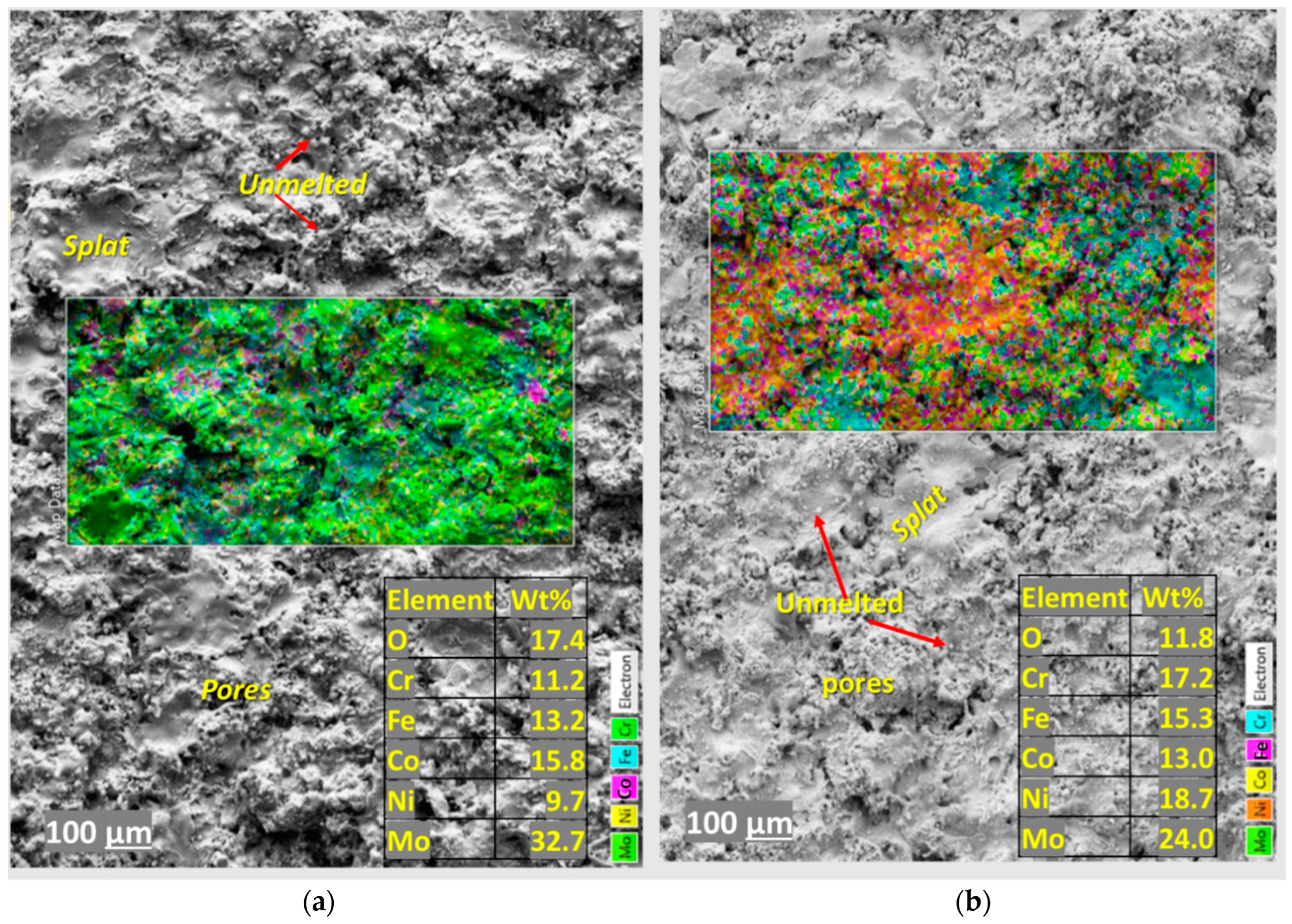
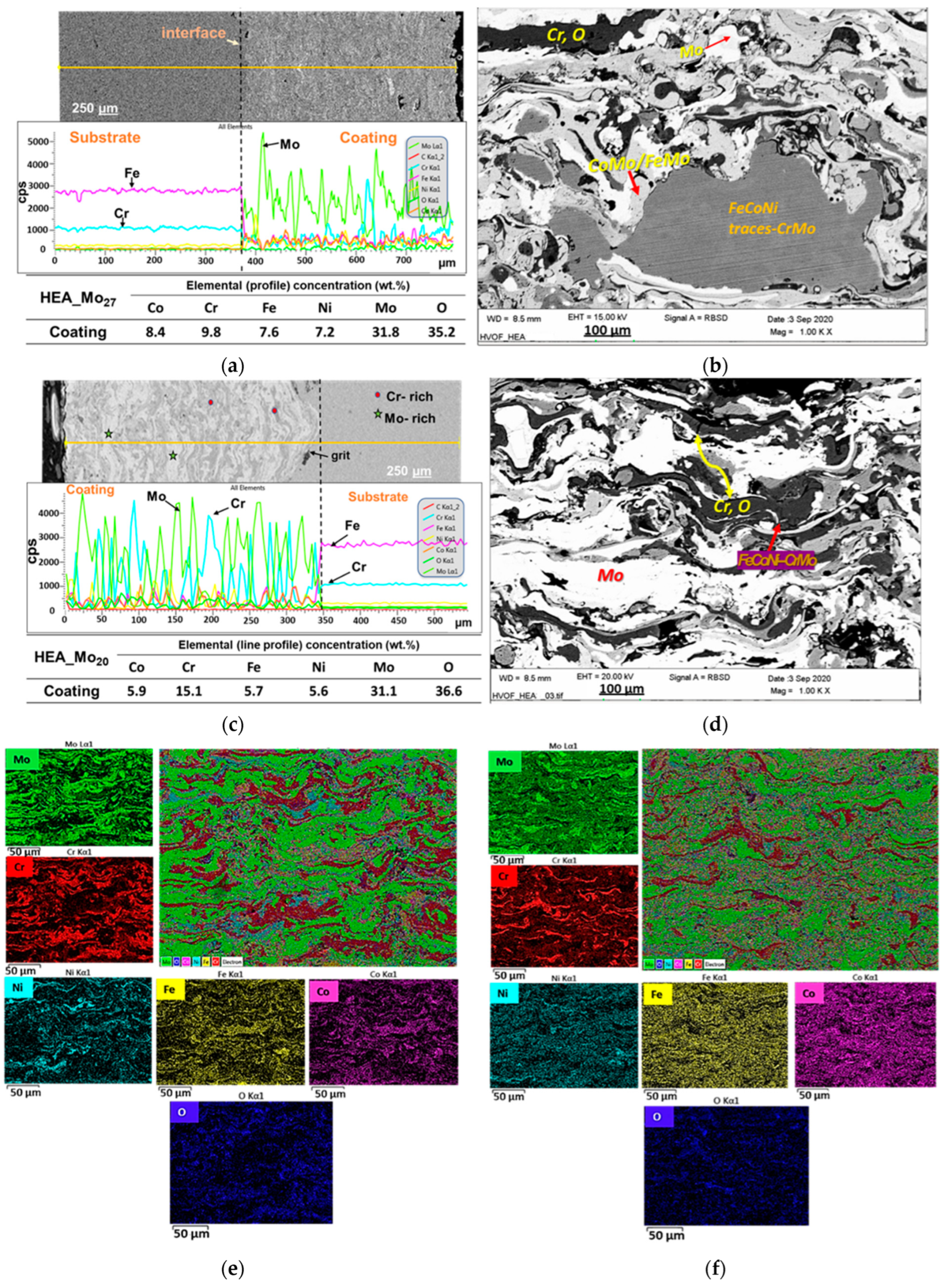
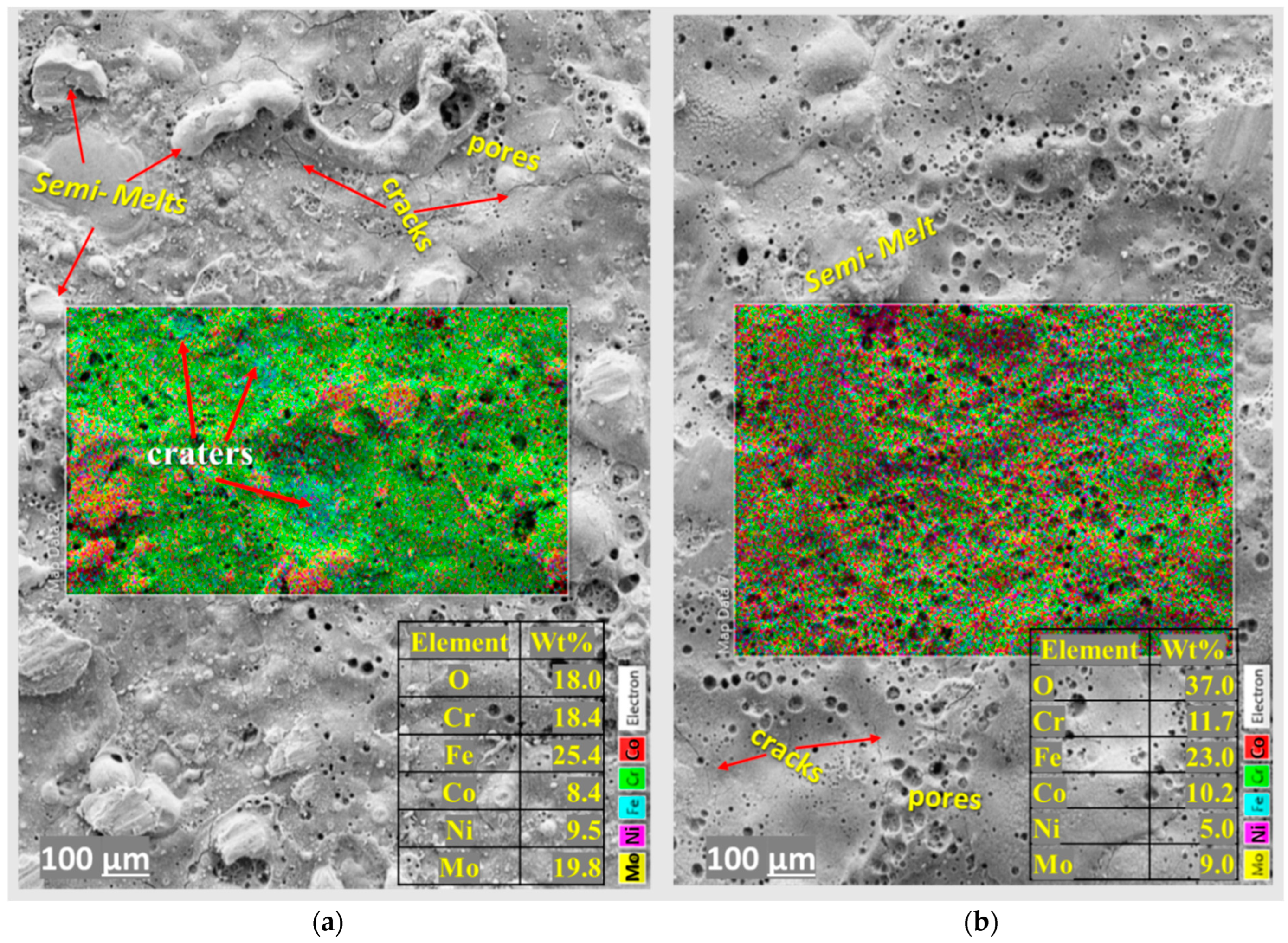
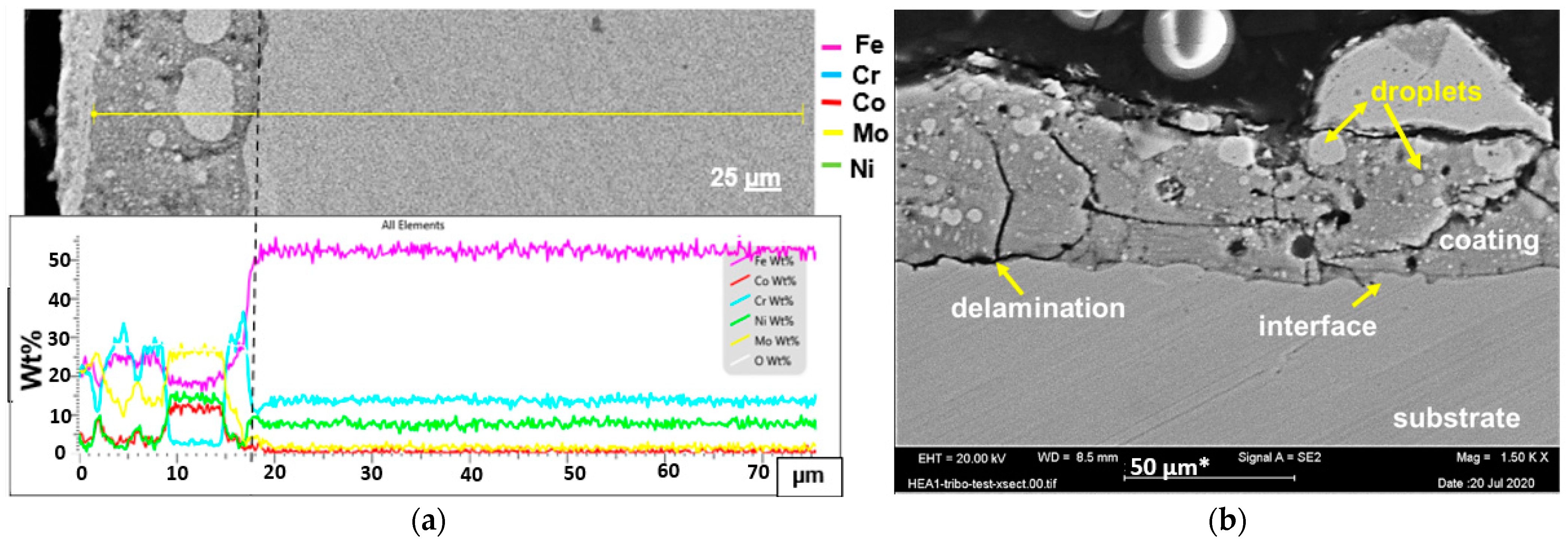

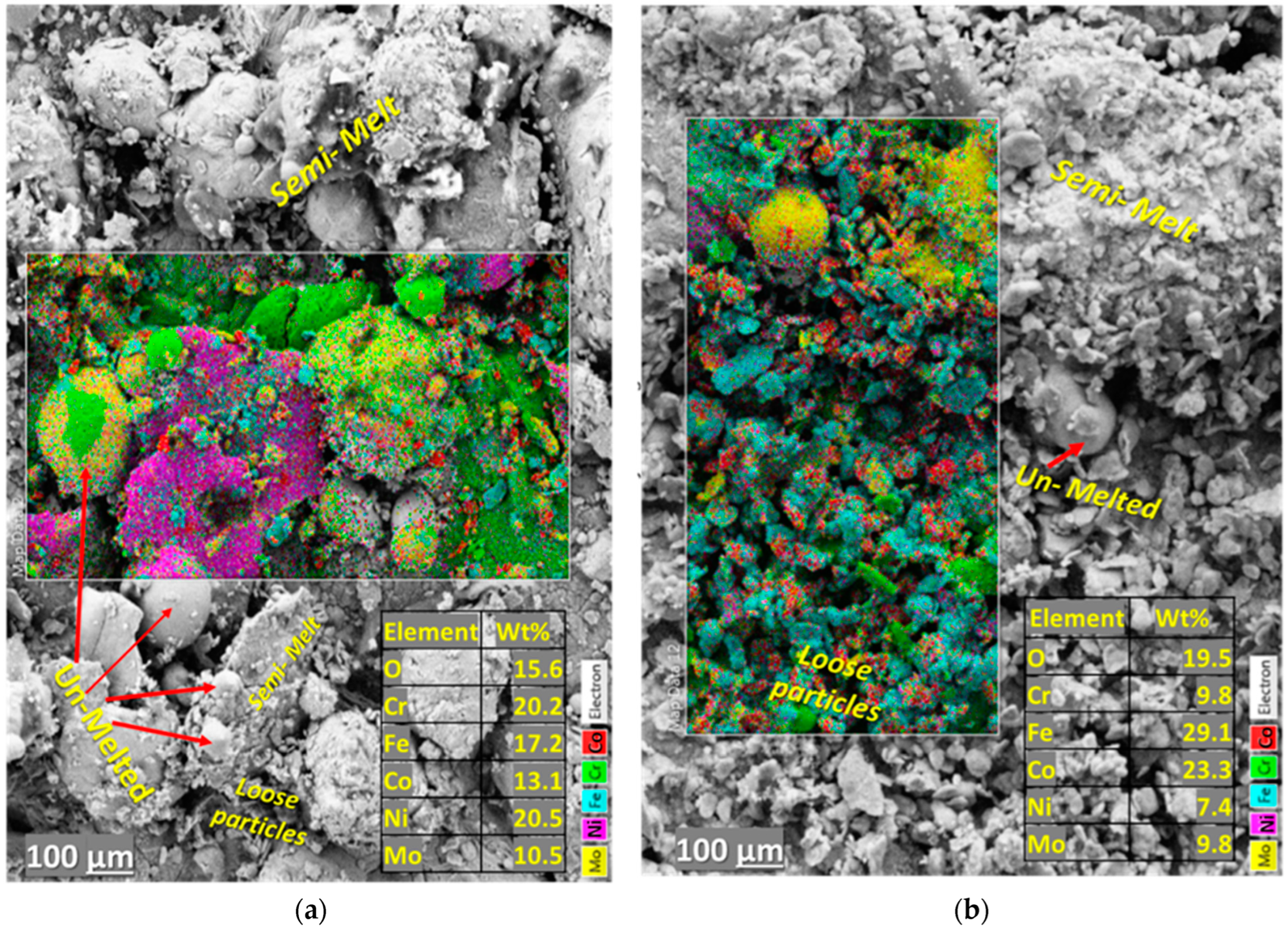

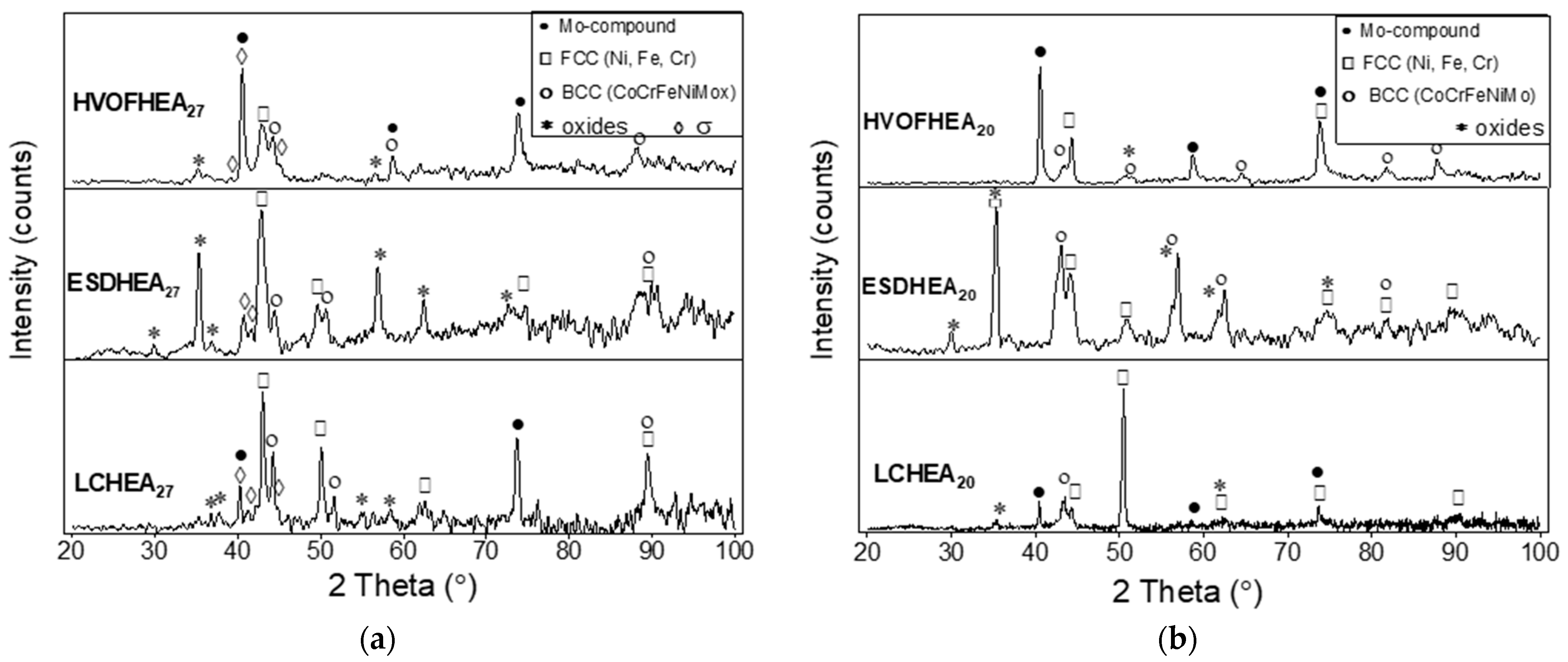
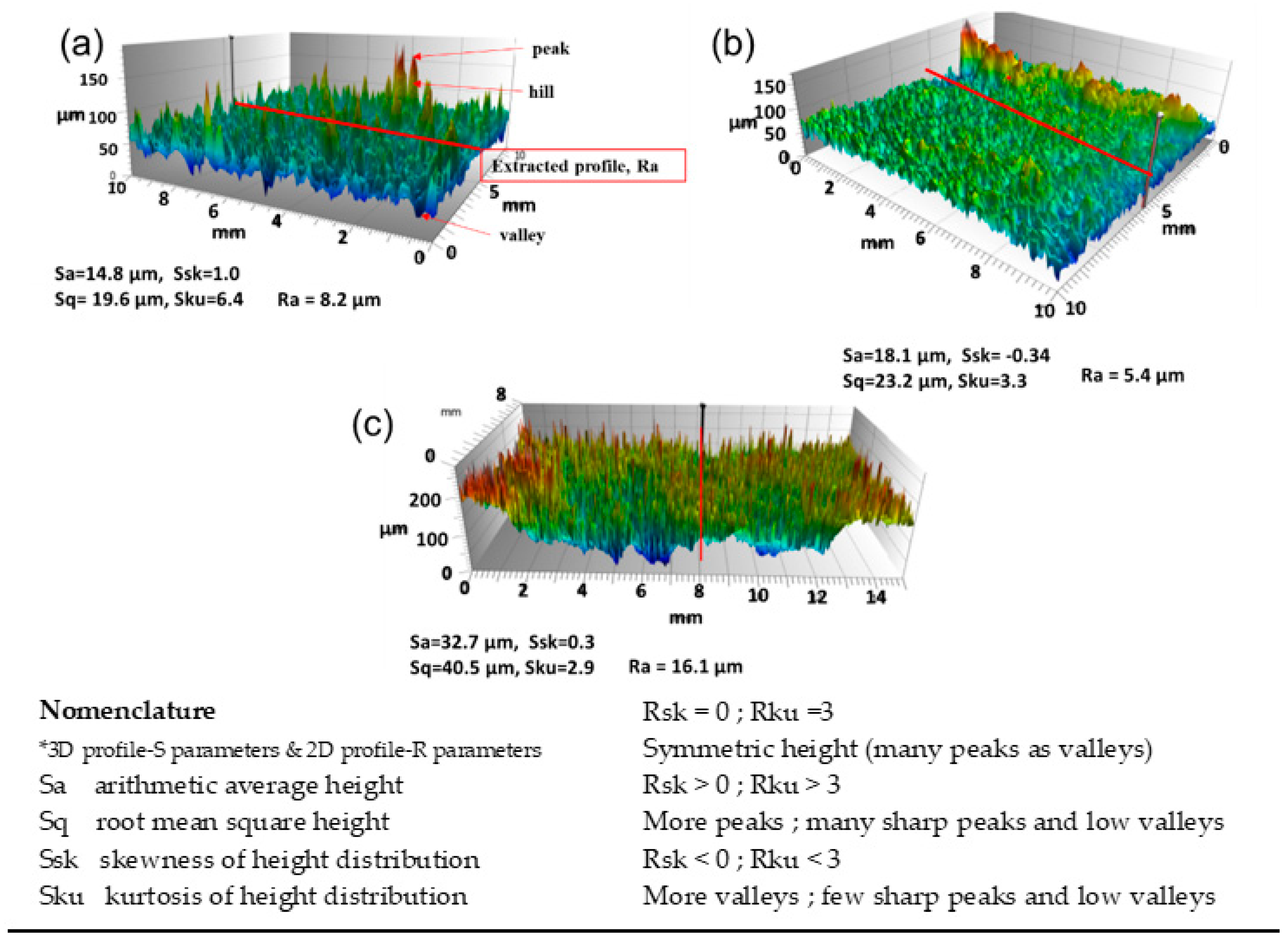
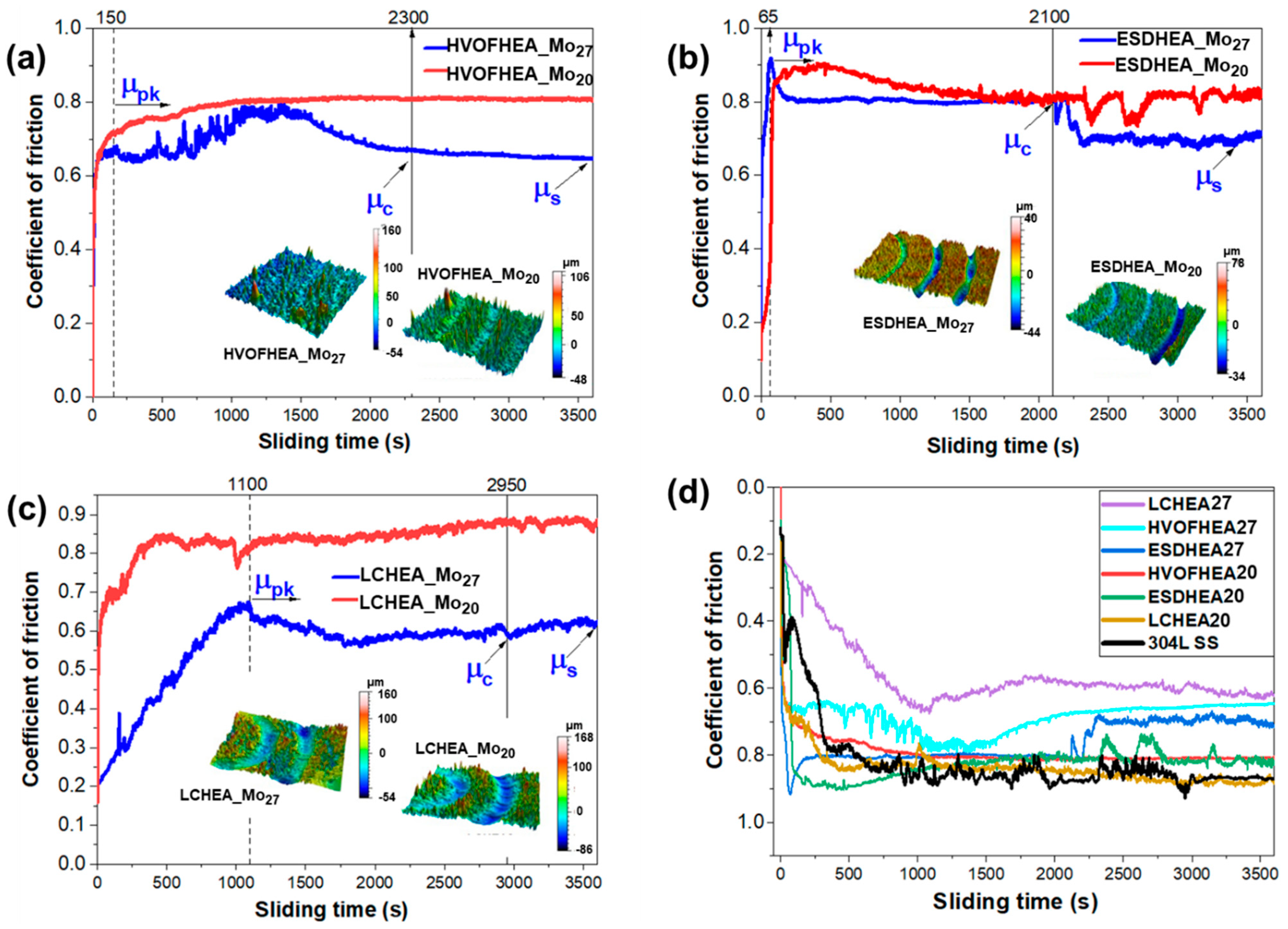
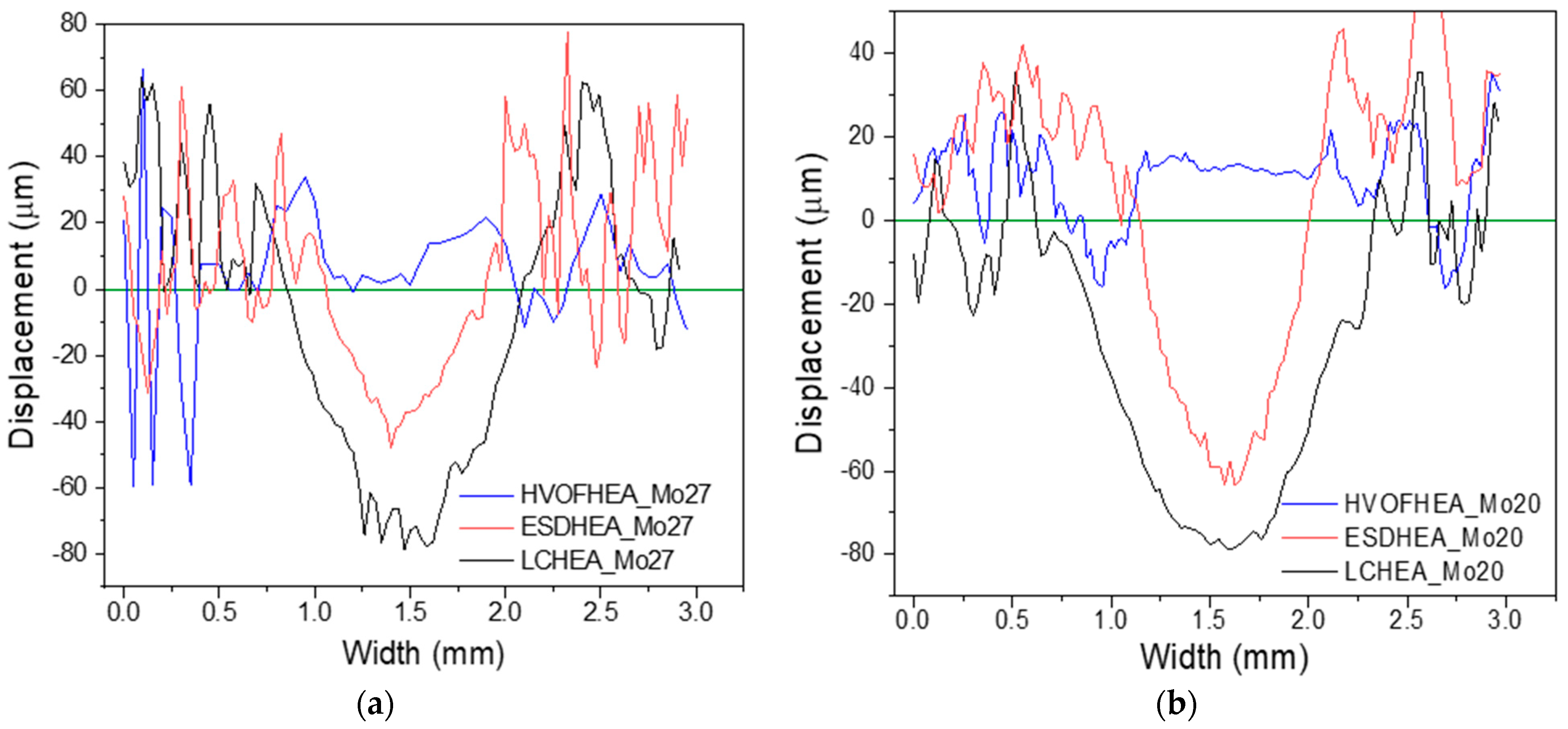
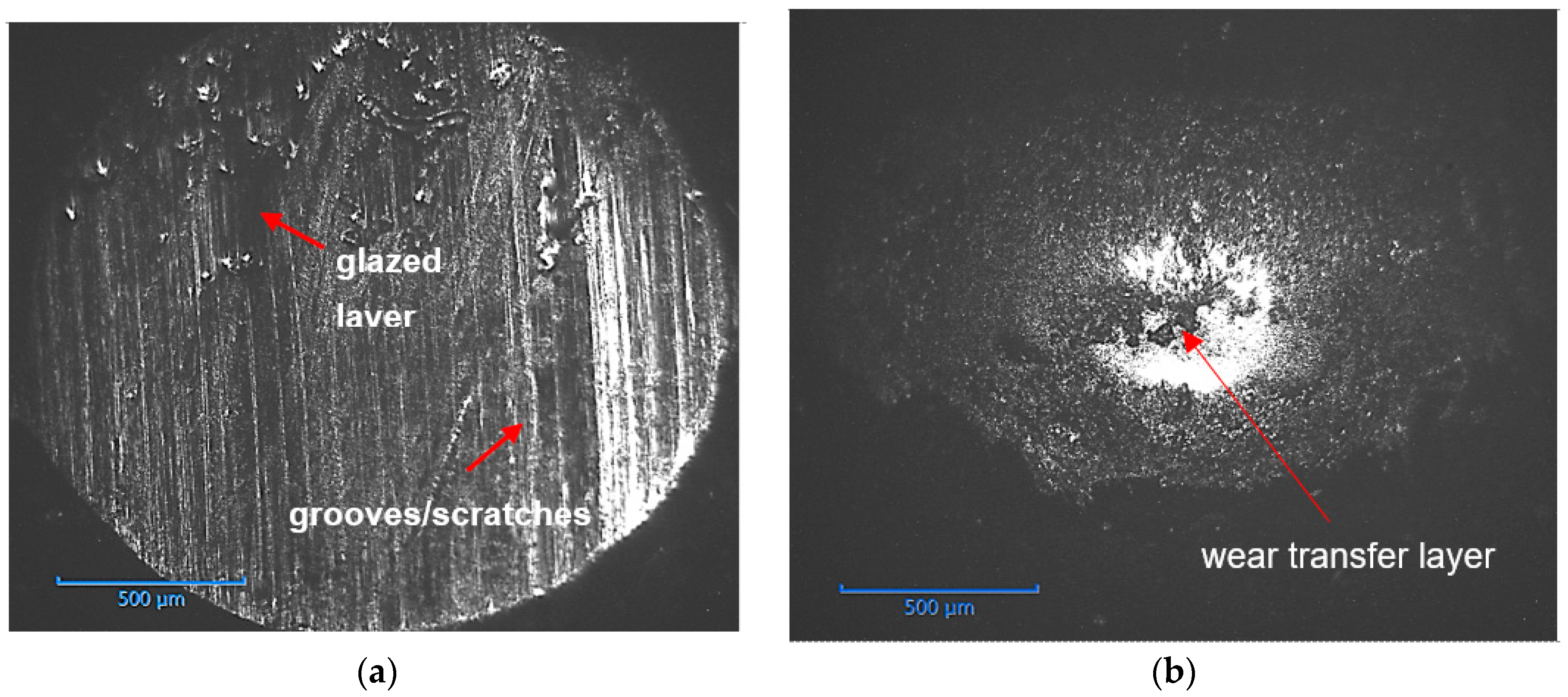

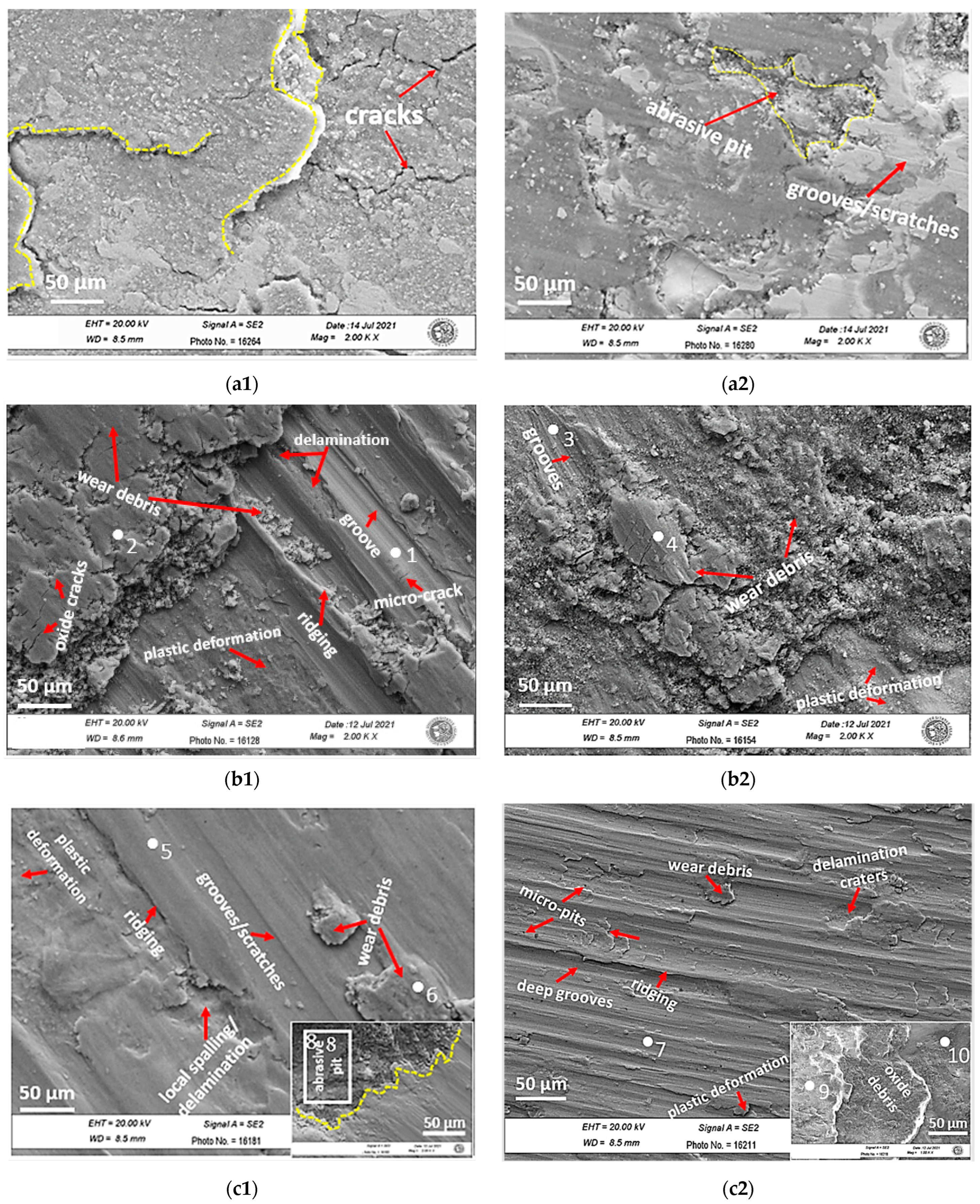
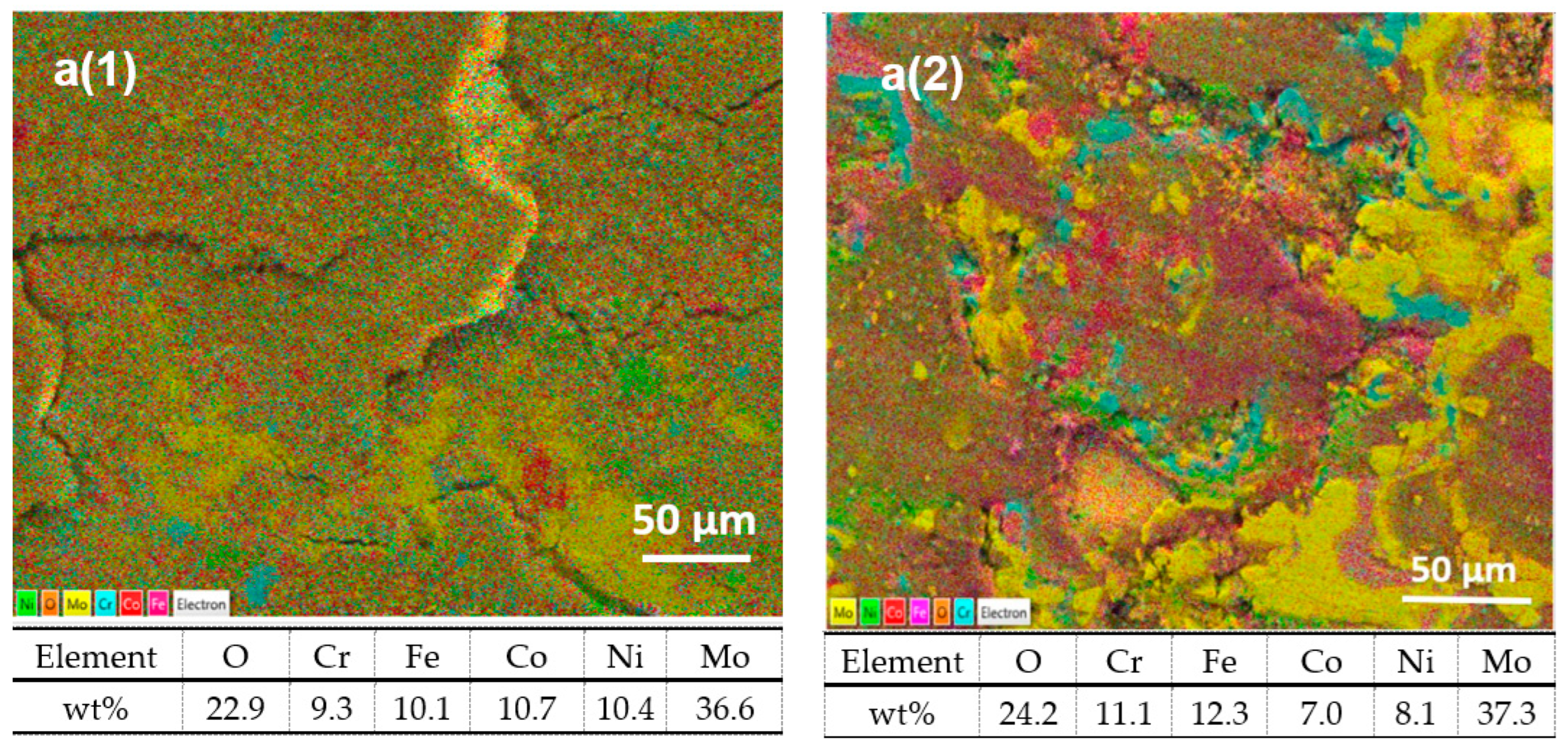
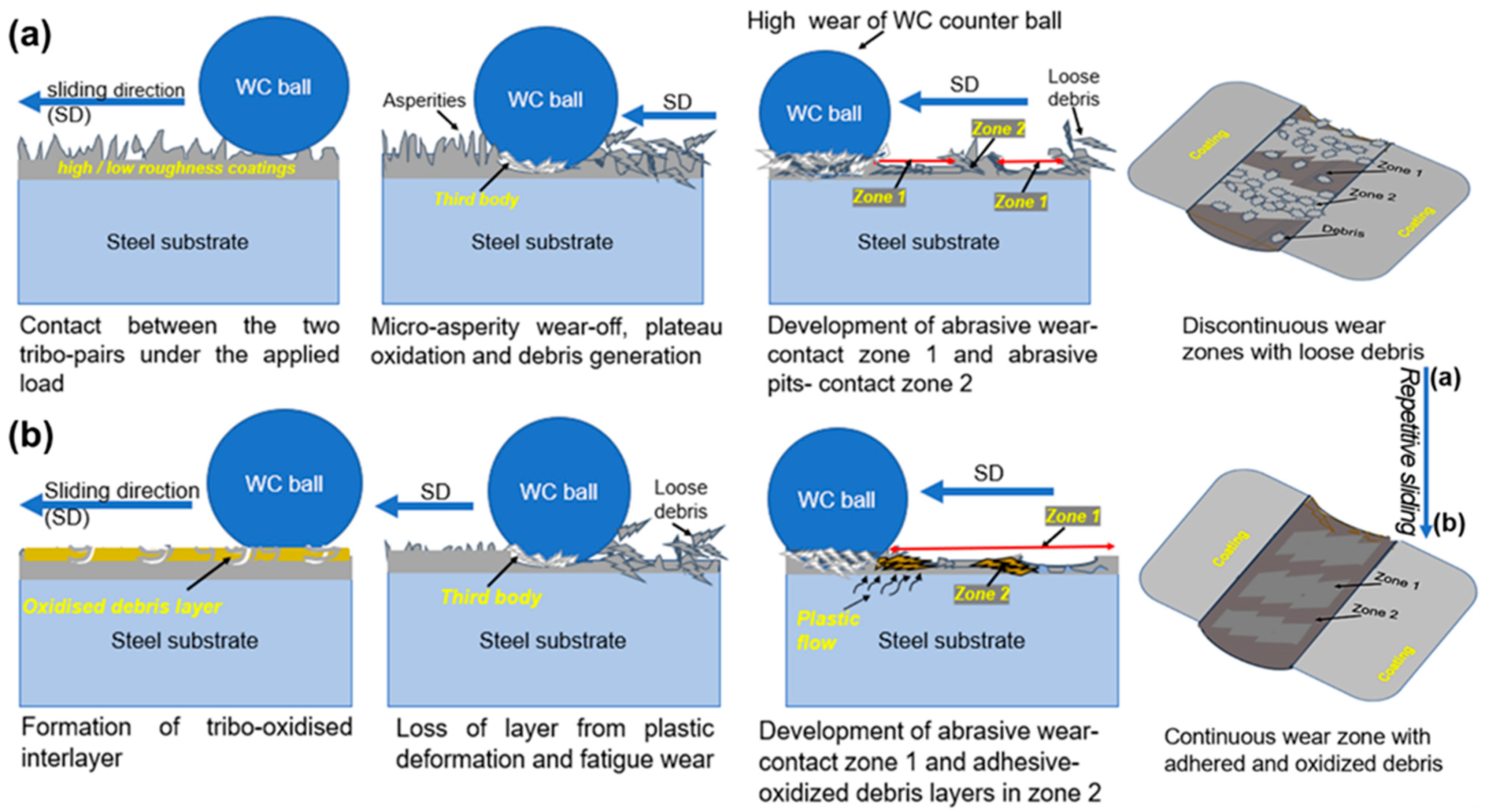
| Coating Type | Nominal Powder Composition (at.%) | Experimental ID | |
|---|---|---|---|
| Co19Cr17Fe19Ni18Mo27 | 19.0% Co, 17.0% Cr, 19.0% Fe, 18.0% Ni, 27.0% Mo | HEA_Mo27 | |
| Co20Cr20Fe20Ni20Mo20 | 20.0% Co, 20.0% Cr, 20.0% Fe, 20.0% Ni, 20.0% Mo | HEA_Mo20 | |
| Powder | Powder size distribution | Coating process | Experimental |
| processing | [μm] | ID | ID |
| Mechanical alloying (MA) | 20–56 | HVOF | HVOF-HEA_Mo27 |
| HVOF-HEA_Mo20 | |||
| 63–125 | LC | LC-HEA_Mo27 | |
| LC-HEA_Mo20 | |||
| MA + Pressing and sintering | 16–45 | ESD | ESD-HEA_Mo27 |
| ESD-HEA_Mo20 | |||
| Capacitance | Voltage (V) | Frequency (Hz) | Atmosphere |
|---|---|---|---|
| 20 µF | 100 | 150 | Argon |
| Process Parameter | Oxygen Flow | Kerosene Flow | Nitrogen Flow | Standoff Distance | Number of Passes |
|---|---|---|---|---|---|
| (slpm) | (slpm) | (slpm) | (mm) | (–) | |
| Value | 834 | 0.33 | 12.27 | 360 | 20 |
| Sample | Laser Power | Laser Speed | Overlap Rate | Powder Disk Speed Parameter | Number of Layers | Carrier Gas Flow (Ar) | Shielding Gas Flow (Ar) |
|---|---|---|---|---|---|---|---|
| (W) | (mm/s) | (%) | (%) | (–) | (L/min) | (L/min) | |
| HEA_Mo27 | 550 | 10 | 33 | 9.3 | 1 | 4 | 6 |
| HEA_Mo20 | 400 | 10 | 33 | 9.3 | 1 | 4 | 6 |
| Coating ID | µpk | µc | µs | µmean (CoFmean) 12,000 Cycles | Wear Rate (mm3/Nm) |
|---|---|---|---|---|---|
| HVOF-HEA_Mo27 | 0.82 | 0.71 ± 0.05 | 0.70 ± 0.17 | 0.69 ± 0.04 | 1.34 × 10−5 |
| ESD-HEA_Mo27 | 0.92 | 0.80 ± 0.02 | 0.70 ± 0.02 | 0.76 ± 0.06 | 2.24 × 10−4 |
| LC-HEA_Mo27 | 0.71 | 0.59 ± 0.03 | 0.63 ± 0.03 | 0.56 ± 0.99 | 4.41 × 10−4 |
| Experimental ID | Av. Roughness | Vickers Hardness | Coating Thickness | CoF | Wear Depth | Wear Rate |
|---|---|---|---|---|---|---|
| (Ra) | (HV) | (µm) | (–) | (µm) | (mm3/Nm) | |
| 304 SS – Reference steel | 0.12 ± 0.04 | 189 ± 24 | - | 0.80 ± 0.11 | 20.4–26.6 | 2.56 × 10−4 |
| HVOF-HEA_Mo27 | 8.2 ± 0.3 | 445 ± 51 | 418.7 ± 43 | 0.68 ± 0.12 | 9.50–13.9 | 1.34 × 10−5 |
| ESD-HEA_Mo27 | 5.4 ± 0.3 | … 1 | 23.5 ± 5 | 0.79 ± 0.03 | 22.4–39.4 | 2.24 × 10−4 |
| LC-HEA_Mo27 | 16.1 ± 0.6 | 276 ± 19 | 1200 ± 0.1 | 0.56 ± 0.20 | 29.1–59.0 | 4.41 × 10−4 |
| HVOF-HEA_Mo20 | 8.6 ± 0.4 | 414 ± 83 | 313.8 ± 24 | 0.81 ± 0.09 | 12.0–21.6 | 7.17 × 10−5 |
| ESD-HEA_Mo20 | 5.5 ± 0.4 | … 1 | 28.8 ± 6 | 0.81 ± 0.08 | 25.8–44.1 | 3.16 × 10−4 |
| LC-HEA_Mo20 | 17.2 ± 0.4 | 209 ± 7 | 1300 ± 0.1 | 0.83 ± 0.15 | 39.5–111 | 6.79 × 10−4 |
| Location | Elemental Concentration (wt%) | |||||
|---|---|---|---|---|---|---|
| O | Cr | Fe | Co | Ni | Mo | |
| point 1 | 0.4 | 17.8 | 69.1 | 0.4 | 10.4 | 1.9 |
| point 2 | 11.9 | 15.5 | 61.1 | 0.4 | 9.1 | 2.0 |
| point 3 | 0.8 | 17.7 | 68.3 | 0.4 | 10.9 | 1.9 |
| point 4 | 23.5 | 13.9 | 52.7 | 0.4 | 8.0 | 1.5 |
| point 5 | 1.4 | 14.6 | 43.5 | 8.1 | 14.6 | 17.8 |
| point 6 | 13.4 | 13.9 | 31.1 | 8.6 | 14.9 | 18.1 |
| point 7 | 1.7 | 15.8 | 50.3 | 6.3 | 17.6 | 8.3 |
| area 8 | 29.2 | 60.4 | 5.9 | 1.1 | 1.6 | 1.8 |
| point 9 | 28.6 | 13.0 | 35.3 | 4.0 | 13.5 | 5.6 |
| point 10 | 22.0 | 70.7 | 4.4 | 1.2 | 0.8 | 0.9 |
| Experimental ID | Elemental Concentration (wt%) | |||||
|---|---|---|---|---|---|---|
| O | Cr | Fe | Co | Ni | Mo | |
| ESD-HEA_Mo27 | 3.65 | 17.12 | 66.29 | 0.54 | 10.3 | 2.11 |
| LC-HEA_Mo27 | 3.49 | 15.08 | 42.63 | 7.46 | 14.23 | 17.11 |
| ESD-HEA_Mo20 | 6.07 | 16.73 | 64.4 | 0.99 | 9.83 | 1.96 |
| LC-HEA_Mo20 | 1.7 | 15.81 | 50.3 | 6.31 | 17.63 | 8.25 |
Publisher’s Note: MDPI stays neutral with regard to jurisdictional claims in published maps and institutional affiliations. |
© 2022 by the authors. Licensee MDPI, Basel, Switzerland. This article is an open access article distributed under the terms and conditions of the Creative Commons Attribution (CC BY) license (https://creativecommons.org/licenses/by/4.0/).
Share and Cite
Oppong Boakye, G.; Geambazu, L.E.; Ormsdottir, A.M.; Gunnarsson, B.G.; Csaki, I.; Fanicchia, F.; Kovalov, D.; Karlsdottir, S.N. Microstructural Properties and Wear Resistance of Fe-Cr-Co-Ni-Mo-Based High Entropy Alloy Coatings Deposited with Different Coating Techniques. Appl. Sci. 2022, 12, 3156. https://doi.org/10.3390/app12063156
Oppong Boakye G, Geambazu LE, Ormsdottir AM, Gunnarsson BG, Csaki I, Fanicchia F, Kovalov D, Karlsdottir SN. Microstructural Properties and Wear Resistance of Fe-Cr-Co-Ni-Mo-Based High Entropy Alloy Coatings Deposited with Different Coating Techniques. Applied Sciences. 2022; 12(6):3156. https://doi.org/10.3390/app12063156
Chicago/Turabian StyleOppong Boakye, Gifty, Laura E. Geambazu, Arna M. Ormsdottir, Baldur G. Gunnarsson, Ioana Csaki, Francesco Fanicchia, Danyil Kovalov, and Sigrun N. Karlsdottir. 2022. "Microstructural Properties and Wear Resistance of Fe-Cr-Co-Ni-Mo-Based High Entropy Alloy Coatings Deposited with Different Coating Techniques" Applied Sciences 12, no. 6: 3156. https://doi.org/10.3390/app12063156
APA StyleOppong Boakye, G., Geambazu, L. E., Ormsdottir, A. M., Gunnarsson, B. G., Csaki, I., Fanicchia, F., Kovalov, D., & Karlsdottir, S. N. (2022). Microstructural Properties and Wear Resistance of Fe-Cr-Co-Ni-Mo-Based High Entropy Alloy Coatings Deposited with Different Coating Techniques. Applied Sciences, 12(6), 3156. https://doi.org/10.3390/app12063156








